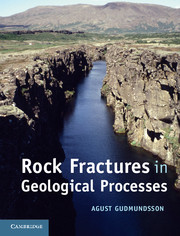Book contents
- Frontmatter
- Contents
- Preface
- Acknowledgements
- 1 Introduction
- 2 Stress
- 3 Displacement and strain
- 4 Relation between stress and strain
- 5 Loading of brittle rocks to failure
- 6 Stress concentration
- 7 Theories of brittle failure of rocks
- 8 Extension fractures and shear fractures
- 9 Displacements and driving stresses of fractures
- 10 Toughness and fracture mechanics
- 11 Field analysis of extension fractures
- 12 Field analysis of faults
- 13 Evolution of extension fractures
- 14 Evolution of faults
- 15 Fluid transport in rocks – the basics
- 16 Fluid transport in faults
- 17 Fluid transport in hydrofractures
- Appendix A Units, dimensions, and prefixes
- Appendix B The Greek alphabet
- Appendix C Some mathematical and physical constants
- Appendix D Elastic constants
- Appendix E Properties of some crustal materials
- Index
- References
11 - Field analysis of extension fractures
Published online by Cambridge University Press: 05 June 2012
- Frontmatter
- Contents
- Preface
- Acknowledgements
- 1 Introduction
- 2 Stress
- 3 Displacement and strain
- 4 Relation between stress and strain
- 5 Loading of brittle rocks to failure
- 6 Stress concentration
- 7 Theories of brittle failure of rocks
- 8 Extension fractures and shear fractures
- 9 Displacements and driving stresses of fractures
- 10 Toughness and fracture mechanics
- 11 Field analysis of extension fractures
- 12 Field analysis of faults
- 13 Evolution of extension fractures
- 14 Evolution of faults
- 15 Fluid transport in rocks – the basics
- 16 Fluid transport in faults
- 17 Fluid transport in hydrofractures
- Appendix A Units, dimensions, and prefixes
- Appendix B The Greek alphabet
- Appendix C Some mathematical and physical constants
- Appendix D Elastic constants
- Appendix E Properties of some crustal materials
- Index
- References
Summary
Aims
What measurements can we make in the field so as to be able to use the analytical framework developed in earlier chapters? In particular, how do we analyse extension fractures in the field? The main aims of this chapter are to:
Give field examples of the main types of extension fractures.
Illustrate how the most important field measurements of extension fractures are made.
Provide typical field data on tension fractures.
Provide typical field data on joints.
Provide typical field data on mineral veins.
Provide typical field data on dykes.
Provide data on man-made hydraulic fractures.
Illustrate the connection between extension fractures and faults.
Outline the general methods of field measurements of fractures.
Types of extension fractures
Tension fractures are formed by absolute tension, so that they are mostly confined to the shallow parts of the crust (Chapter 8). Hydrofractures are partly or entirely generated by an internal fluid overpressure and can form at any crustal depth if there is high fluid pressure. Tension fractures include many large tension fractures in rift zones, as well as many joints. Hydrofractures are fluid-driven rock fractures that include many joints, mineral veins, and dykes. Man-made fractures injected under fluid overpressure into reservoir rocks to increase their permeabilities, commonly referred to as hydraulic fractures, are also hydrofractures. In many hydrofractures, for example fractures formed by gas, oil, and ground water, the fluid may disappear after the fracture has formed. Other hydrofractures, such as dykes, are driven open by fluids that solidify in the fracture once it is formed.
- Type
- Chapter
- Information
- Rock Fractures in Geological Processes , pp. 319 - 353Publisher: Cambridge University PressPrint publication year: 2011



